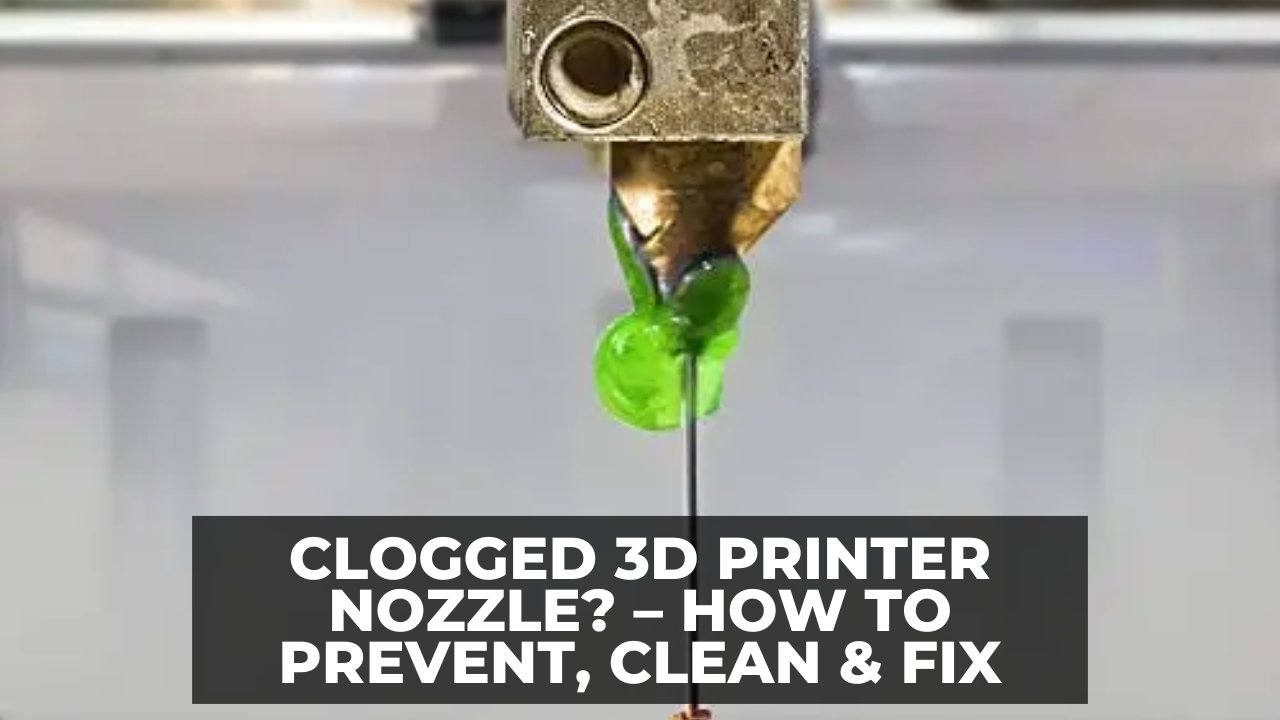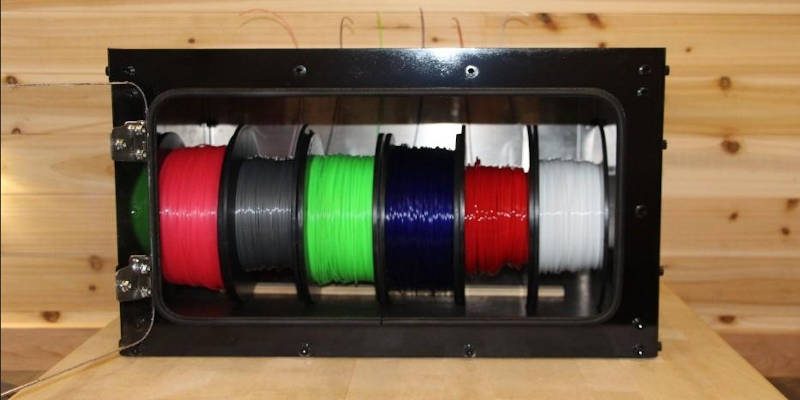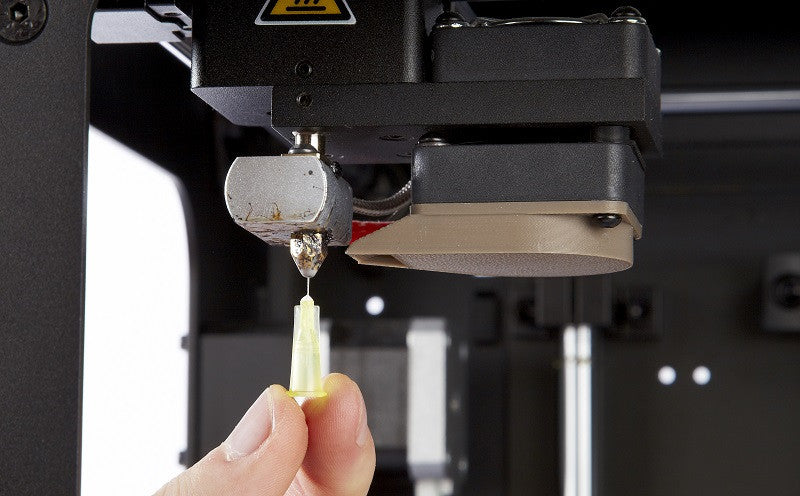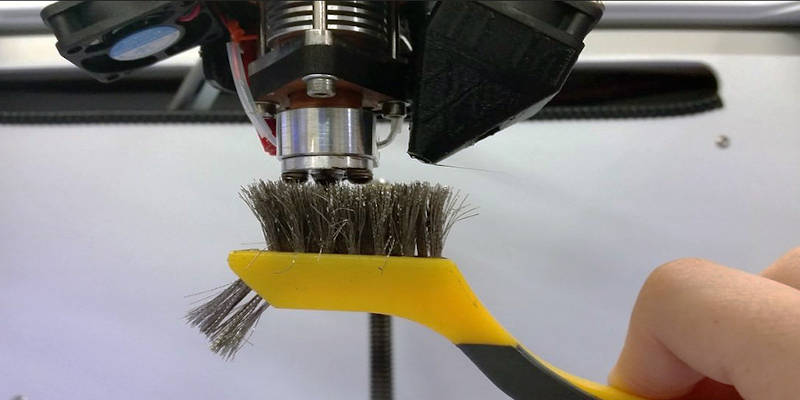
Clogged 3D Printer Nozzle? – How to Prevent, Clean & Fix


At 3DSourced we’ve covered everything 3D printing and 3D since 2017. Our team has interviewed the most innovative 3D printing experts, tested and reviewed more than 20 of the most popular 3D printers and 3D scanners to give our honest recommendations, and written more than 500 3D printing guides over the last 5 years.
In 3D printing, there’s little more irritating than a clogged extruder nozzle.
When everything seems to be progressing nicely when suddenly you hear a clicking or knocking sound from your extruder motor.
You look over and see that your 3D printer is not extruding, the filament isn’t moving off of the spool and the nozzle is now moving around in thin air above what’s left of your print.
In this guide, we’ll discuss the four most common causes of a clogged nozzle I’ve found in my years 3D printing, namely:
I’ll share my most effective techniques for each of these issues, and the steps I take to prevent clogging before it starts.
(Not a complete blockage? Cleaning Filament can handle a partial blockage and save you some hassle)
Why Does my 3D Printer Keep Clogging (and How to Avoid it!)

A clogged print nozzle is usually caused by one of several common problems.
So, even though a clogged print nozzle is one of those “Are you kidding me, really?” issues that everyone dreads, the good news is that the problem can easily be prevented from occurring by simply paying attention to a couple of things beforehand.
Don’t worry, we’ll cover cleaning a 3D printer nozzle later in the article. You’ll learn how to unclog a 3D printer nozzle in no time.
Incorrect Nozzle Height
As you probably know, your nozzle has to be at the correct height from your print surface in order for you to successfully print an object.
If the nozzle is too high, the print material has to travel a longer distance to reach the surface. This longer distance translates into cooler temperatures. The result is that your material will likely have trouble adhering.

But if the nozzle is too low, a couple of undesirable things will occur. First, there won’t be sufficient room between the nozzle and the print surface to allow the material to extrude correctly.
This will result in the nozzle smearing the thermoplastic all over the surface.
Second, the insufficient room between the nozzle and the surface will begin to cause retrograde extrusion – the material will begin to back up into the nozzle, ultimately causing a clog.

The easy fix for this problem is to make sure that your print bed is leveled correctly and that your starting Z coordinates are sufficient to allow adequate room for proper extrusion.
In general, your Z coordinate should be no higher than the diameter or lower than 1/4 diameter of your print nozzle.
This will allow the nozzle to maintain a slight pressure to the top of the extruded filament which will increase adhesion while avoiding retrograde extrusion.
Incorrect Print Temperature
Correct print temperature is critical for both a successful print run and for printer performance. If the temperature of your hot end is too low, your print material will not melt correctly.
This can cause the material to begin to adhere to the inside surface of the nozzle. This causes pressure to build up in the print head.
Eventually, the extrusion motor can’t feed the filament into the head and before you know it your 3D printer nozzle is clogged.
In addition, printing at too high a temperature, especially with PLA, can cause you to experience what is known as “heat creep”. Essentially, heat creep occurs when higher temperatures extend back and upwards from the hot end.

This causes the “melt area” to extend father back as well, softening and melting the print material well before the nozzle end of the extruder. The softened thermoplastic increases the amount of pressure needed for extrusion.
As with having your print temperature too low, eventually the extrusion motor can’t keep up and the nozzle gets clogged.
In extreme cases of printing at too higher temperatures – PLA and similar filaments can actually crystallize in the nozzle.
You can avoid this problem by always checking to make sure that you’re printing at the recommended temperature for the material that you’re using.
PLA does well at temperatures around 180C and up and ABS likes temperatures around 225C+. Experiment with the material that you’re using and find the “sweet spot” that allows for good adhesion and layering, but doesn’t cause problems like clogging.
In addition, when you are changing materials, always make sure that you’ve removed the previous material completely and flushed it through before changing print temperatures. Failure to do so may also cause a clogged nozzle later on.
Poor Quality or ‘Wet’ Filament
Not all filaments are created equal. Low-quality filament is not subjected to rigorous tolerance tests. This can result in an end product that has differing widths throughout the filament strand.
Segments of the filament that have a thicker diameter will not only take longer to melt, but they will also be more difficult to extrude and may cause a clog, although admittedly this is rare.
The main cause of poor quality filament and its frequent blocking is what’s inside the resin.
Cheaper filler and unintended contaminants lurking inside the material can build up or outright clog inside the nozzle at random intervals.
Finding that your 3D printer nozzle keeps clogging? It’s likely down to poor-quality filament.
There is an easy way to check the quality of extrusion consistency with the filament that you’re using. Take a pair of calipers and check the diameter of your filament at several different points.
If you’re finding significant deviation from the advertised diameter specifications, it might be time to start thinking about obtaining your filament from a different source. We recommend the top filament brands here.
In addition, if you haven’t stored your filaments in a cool, dry place away from moisture, they’ll absorb some of this water vapor over time as they’re hygroscopic. These ‘wet’ filaments are more likely to clog, and generally print worse quality prints with rougher surface finishes from the ‘bubbling’ in the filament.
You can buy filament dryers to dry your wet filament, and also take action by using filament storage, or even make yourself a DIY filament dry box.

Dust and Dirt
Despite your best efforts, dust and dirt can still become adhered to your filament and travel with it down into your hot end. Once there, they burn in the heat of the nozzle and start adhering to the inside surface of the nozzle as carbon.
When enough carbon builds up on the inside of the nozzle it can start to narrow the width of the nozzle opening, as well as begin to impede the flow of the print material.
The end result can be a clog. We’ll discuss a fix for this problem in the next section.
How to Unclog a 3D Printer Nozzle
When you’ve got a completely clogged print nozzle there are a number of 3D printer nozzle cleaning techniques that you can use to get it unclogged depending on the material that’s causing the problem.
The first way that we always recommend for partially blocked nozzles is to use cleaning filament regularly – however, that won’t unblock a fully clogged nozzle.
Let’s take a look at some of these other methods for how to clean a clogged 3D printer nozzle.
If you’ve only got a partial blockage or slight under extruding though, there is a much easier way. Keep reading to learn more.
The Atomic or Cold Pull Method
This is a technique that works great if you have a build-up of carbon or carbonized material in your nozzle that’s causing the clog. It also works well if your clog was caused by the switch from a high temperature to a lower temperature printing material.
You can check out the specifics of how to use this method by taking a look at our article on under extrusion problems that can be found here.
But generally, if you heat the hotend to 250-260°C, it will dislodge any stuck materials. Then, allow it to cool, and heat up again to around 115°C+ and manually push the filament through the nozzle at it heats up to thoroughly dislodge any stuck material.
Although we find the 3D printer cold pull method to be effective, it’s very brutal and time-consuming on your machine. Read on to learn about our preventative measures and using 3D printer nozzle cleaner.
Guitar Strings and Acupuncture Needles

Another method to break out a clog is to essentially break through it using anything strong and narrow. A surgical or acupuncture needle or a B or high E steel guitar string all make excellent routers.
Our favorite nozzle cleaning tool is a hypodermic needle – you can pick them up quite cheaply online. It goes without saying to just be really careful using them.
Simply heat your hot end up to the printing temperature of the material that’s involved in the clog.
Using a pair of pliers, carefully insert the needle or guitar string into the nozzle opening and move it back and forth, essentially breaking through and removing the clogged material.
The Solvent Method
If the material that is causing the clog is somewhat easily soluble then removing the nozzle and soaking it in the solvent in question can provide a solution to really tough clogs.
Every FDM printer has a slightly different technique that’s involved when removing a printer nozzle.
Take a look at your owner’s manual for the specific methods that apply to your printer. Once the nozzle is removed, place it in a container filled with the appropriate solvent.
For example, if you’re trying to dissolve a clog caused by ABS, you’d place the nozzle in a glass container filled with acetone. Leave the nozzle in the solvent for 24 hours, agitating it every few hours.
After 24 hours is up, remove the nozzle from the solvent and using a steel guitar string or needle remove as much of the plastic clog as possible. If necessary, repeat the solvent bath for another 24 hours and again attempt to unblock the clog.
It’s sometimes the sad truth that if this is your last resort and has still not worked on your extruder nozzles, you may need to dispose of the nozzle and get a new one.
Sometimes if all else fails, you may just need to buy a new nozzle – which although is a little more expensive if you have a solid blockage and you’ve tried the above steps, it could be your only option.
Brushing to Clean the Nozzle
Learning how to clean a 3D printer nozzle can be just as simple as learning to brush your teeth.
If you have a durable nozzle, a simple wire brush is the most effective way to ensure your extruder is free for miscellaneous material or debris that can lead to increased pressure and troublesome clogs.

Like using a paperclip, by thoroughly scrubbing in all directions with a wire brush, extra parts will become dislodged from the heat-end and prevent further buildup, similar to decalcifying a faucet.
Using a softer brush will yield less effective results, but is recommended for weaker nozzles that could become damaged by high-friction scrubbing.
How To Prevent Nozzle Clogs: Cleaning Your Nozzle
One of the best ways for cleaning an extruder nozzle is to never have a clog happen in the first place. As we discussed, proper printer settings and high-quality filament can go a long way to preventing clogs from happening.
Sometimes you can’t prevent a long-term build-up of particles, dust, and over-cooked filament residue lurking in your nozzle, ready to block it at any moment.
That’s when you need an effective 3D printer nozzle cleaner.
The most effective of which is to regularly use a good quality cleaning filament to remove any remaining plastic and contaminants that might remain in the nozzle between print jobs.
Using good quality 3D printer cleaning filament will actually strip out all but completely blocked nozzles. Ours is completely non-abrasive too, so there’s no detriment to your nozzle.
Cleaning filaments operate at a wide range of temperatures. The purging compound in the filament sticks to contaminants and mechanically removes them when the cleaning filament itself is extruded through the hot end.
It’s an easy way to maintain your printer, allowing you to avoid nozzle clogs that can delay your ability to print the objects that you need.
To find out more about cleaning filaments, we recommend you read this article.
Related articles:




















